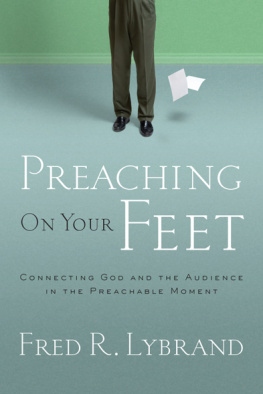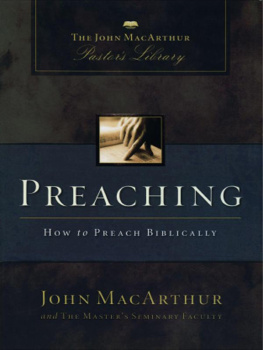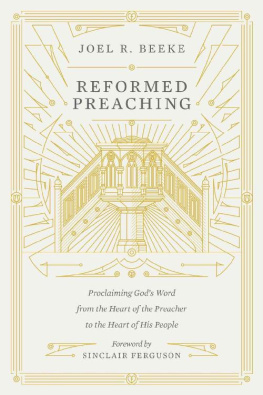A lifetime of preaching and teaching the art of preaching crackles and pops in this bonfire of a book. In sentences of heat and lightblazing passion, luminous intelligenceCalvin Miller, one of our best preachers and writers, tells us what he does bestand why and how.
Eugene Peterson, professor emeritus of spiritual theology, Regent College
Calvin Miller understands preaching. He understands that it is about the heart as well as the mind, about the imaginative as well as the rational, about reaching people as well as teaching the Word, about exegeting a culture as well as expounding a text, and about painting an image as well as stating a proposition. Most of all he understands that preaching is a work of the Spirit who will not be harnessed by our conventions, but who will bless those compelled to tell his story with a pastors care for souls, an apologists zeal for truth, and a poets ear for his cultures heartbeat. Calvin Miller has long been the poet of preachers; now he comes as a master storyteller to teach us how to tell the gospel to a generation thirsting for narratives to explain our world.
Bryan Chapell, president, Covenant Theological Seminary
If you are a preacher, read this book! Calvin Miller has a lot to say about preaching, and he says it well. Preaching: The Art of Narrative Exposition may take a few hours to read, but it can change your preaching for a lifetime.
Haddon Robinson, Harold John Ockenga Professor of Preaching, Gordon-Conwell Theological Seminary
Calvin Miller is a talented preacher and teacher of preachers, and his own gifts are on display in this outstanding volume. Millers book is filled with practical insights that reflect his own rich experience in the pulpit, and his work on narrative exposition is an important contribution that will help both novice and veteran preachers explore new approaches to proclaiming biblical truth. Any preachers work will be strengthened by a careful reading of Millers excellent new book.
Michael Duduit, editor, Preaching Magazine
In this book, Calvin Miller offers an insightful and thought-provoking perspective on one of the central issues facing twenty-first-century preachers: the critical right-brain/left-brain balance in sermon preparation and delivery. Equally important, he shows preachers how to incorporate his perspective in their sermons. For that reason, Preaching: TheArt of Narrative Exposition promises to be an often-consulted preaching resource for a long time to come.
Argile Smith, professor of preaching, occupying the J. D. Gray Chair of Preaching; chair of the division of pastoral ministries, New Orleans Baptist Theological Seminary
Some books on preaching follow a dry academic trail, well-worn by generations of homileticians. In reading such books you are left with the distinct impression that you have covered this territory before. Calvin Miller offers us a fresh approach in Preaching: The Art ofNarrative Exposition. If you are looking for a practical, step-by-step guide to sermon preparation, this is it. But hang onCalvin will take you places you havent been. He will encourage you to take risks, to explore new ways of crafting a sermon that will be memorable as well as biblically substantive. This is a journey every preacher should take.
Reg Grant, professor of pastoral ministries, Dallas Theological Seminary
Its a homiletical autobiography! It communicates the heart and passion of a great preacher as he reveals how he preaches.
David Osborn, director, Denver Seminary Doctor of Ministry Program
Preaching: The Art of Narrative Exposition firmly establishes Calvin Miller as one of the preeminent homileticians of the past half century. Based on decades of solid work in the study and personal experience in the pulpit, this book is simply marvelous. Informative, inspirational, and utterly engaging, its a must-read for all who are involved in the ongoing challenge of biblical preaching in a postmodern culture!
Scott Wenig, professor of applied theology, Denver Seminary
For students and preachers of the Word who desire to turn the ink of the Bible into the blood of living experience through the art of narrative exposition, this book is a necessity and not simply a luxury.
Robert Smith Jr., professor of preaching, Beeson Divinity School
Preaching
Preaching
The Art of Narrative Exposition
Calvin Miller

2006 by Calvin Miller
Published by Baker Books
a division of Baker Publishing Group
P.O. Box 6287, Grand Rapids, MI 49516-6287
www.bakerbooks.com
Published in association with the literary agency of WordServe Literary Group, Ltd., 10152 S. Knoll Circle, Highlands Ranch, CO 80130.
Ebook edition created 2010
Ebook corrections 04.19.2016 (VBN)
ISBN 978-1-4412-0123-2
All rights reserved. No part of this publication may be reproduced, stored in a retrieval system, or transmitted in any form or by any meansfor example, electronic, photocopy, recordingwithout the prior written permission of the publisher. The only exception is brief quotations in printed reviews.
Library of Congress Cataloging-in-Publication Data
Miller, Calvin.
Preaching : the art of narrative exposition / Calvin Miller.
p. cm.
Includes bibliographical references (p. ).
ISBN 10: 0-8010-1290-2 (cloth)
ISBN 978-0-8010-1290-7 (cloth) 1. Preaching. I. Title.
BV4211.3.M55 2006
251dc22
2005035546
Scripture is taken from the HOLY BIBLE, NEW INTERNATIONAL VERSION NIV. Copyright 1973, 1978, 1984 by International Bible Society. Used by permission of Zondervan. All rights reserved.
Scripture marked ASV is taken from the American Standard Version of the Bible.
Contents
Sermonizing is an ought-to sport. In fact preachers enjoy one of the few occupations that allow the freedom of telling people what they ought or ought not to do. This can only be done legitimately as long as they read the Bible before they do it and work at keeping their sermons biblical. The truth is most people go to church expecting to be challenged with the ought-tos of life. Most of us know generally what we ought to do, and want to get on with doing it as long as there is something of God in this oughtness. The Ten Commandments are studies in oughtness; so is the Sermon on the Mount. So are the warnings to the seven churches of Asia. The great ought passages of Scripture have been around for millennia, but their age has never diminished our constant need to be reminded of them. The oughts of life leave us unsettled. To serve them is often wrought with feelings of failure. Preachers certainly havent been able to wrap their own oughts and ought-nots in peace. They ought to do better, live better, and preach better than they do. Preachers ought to quit sinning. Still nobody knows better than those who preach that preaching is an art in which a studied, professional sinner tells the less studied sinners how they ought to believe, behave, and serve. Fortunately the office of preacher carries with it a common understanding that as long as the preacher speaks for God, he should be heard even if he is a sinner. Most people not only believe in God but have some notion that if all the world served God, the world would be a better address. But most people also feel that preachers should shoot straight, and when they say, Thus saith the Lord, they ought to let God do the talking. This oughtness is what differentiates Christ-centered preaching from public speaking.
H omiletics is an intelligent, high-sounding word, and in moments of ego I like calling myself a homiletician. But I am addicted to simplicity, and most of the time I like calling myself by my simpler title: preacher. After reading hundreds of books on the subject and writing a few, I have taken it upon myself to set forth what I have learned, both as a practitioner and a scholar, and cast it in a simple mode. My desire to do this has come from the realization that none of the books on preachingeven the great bookshave done it exactly right. Some get closer to being right than others but none is exactly there. I realize it is just this sort of thinking that keeps creating new books on every subject. New books come from the honest neuroses of scholars who are only trying to make the world better by letting their particular drive to write a perfect book furnish the libraries of the world.
Next page


















